According to Forbes, “remote work is no longer a privilege,” and Fast Company considers it “the new normal.” And according to us? It’s a more productive and lucrative endeavour. With more and more people searching for remote work opportunities every year, we wanted to know what this lifestyle entailed for those already engaging in it, particularly compared to the more traditional office worker.
We surveyed 1,004 full-time employees across the U.S., 505 of whom worked remotely. We compared everything from their productivity to their spending habits and even health to decide if working out of the office simply is the better way to work. Read on to find the answer.
Virtual commutes
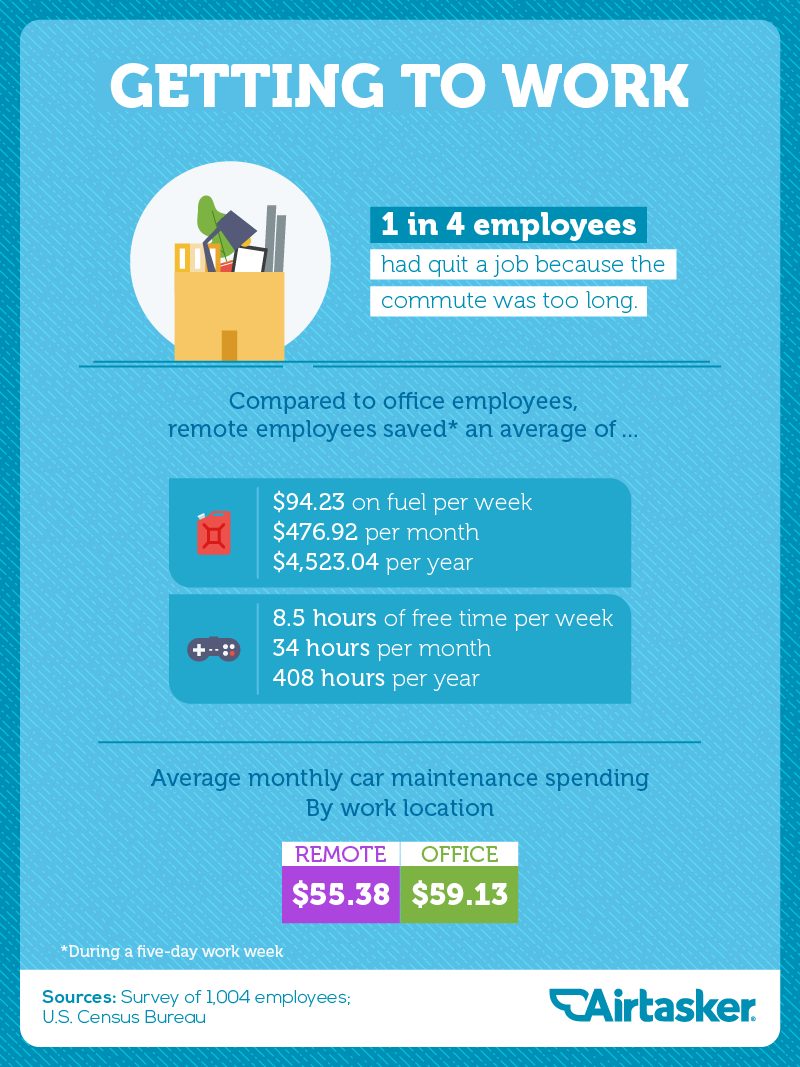
Employee tenure was deeply impacted by commute times. In fact, long commutes caused 1 in 4 respondents to quit a job at some point. For remote employees, however, the “commute” may only last as long as it takes to get to the nearest laptop. And this had a serious impact on both employees’ wallets and free time.
Compared to office employees, remote workers saved an annual average of $4,523 on fuel alone. This also equated to an extra 408 hours, or 17 days, of free time each year for not having to take the time to get from their home to an office. Seventeen days is more than many employees take in a year! Even the biggest car enthusiasts would be hard-pressed to exchange their beloved driving time for that many days of (possibly paid) vacation.
Remote exercising

According to our research, remote employees were healthier in terms of exercise. On average, they clocked in two hours and 44 minutes of physical exercise each week, which was 25 more minutes each week than office workers. Both diet and exercise are important for the health of your employees, which might be why we’re seeing more employers offering wellness benefits.
The benefits of having a healthy workforce are obvious and far-ranging, from taking fewer sick days to maintaining concentration. Moreover, business owners can consider some wellness programs like employee gym memberships as “fringe benefits” and deduct the expenses from their corporate taxes.
Productive places
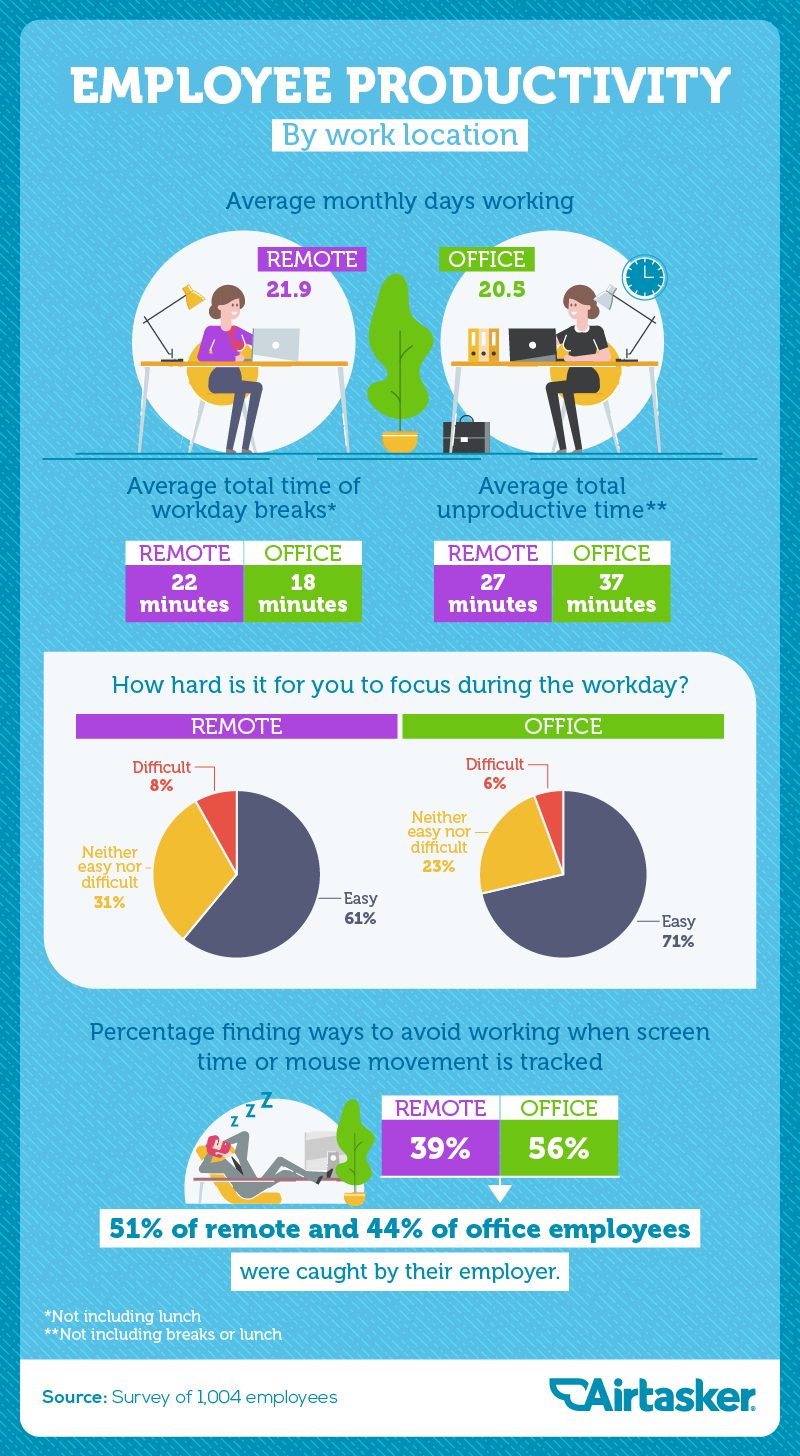
Another key difference between office and remote work? Remote employees work more. On average, remote employees worked 1.4 more days every month, or 16.8 more days every year, than those who worked in an office. And on those workdays, they spent more time getting things done. While office workers reported an average of 37 minutes each workday not getting work done (outside of lunch and standard breaks), remote employees only lost 27 minutes of each workday to distractions. While remote workers did take more time for official breaks than office employees, evidence shows that taking breaks actually leads to higher rates of productivity.
Differences in the ability to concentrate or find focus in and out of the office were minimal: 8% of remote workers found it difficult to focus, compared to 6% of those in the office. The real impact, however, occurred with micromanagement. If employees had their screen and/or mouse time tracked, 39% of remote and 56% of office employees found ways to avoid working. They didn’t always get away with it, though: 51% of remote and 44% of office employees were caught by their employers.
Pro tips for productivity
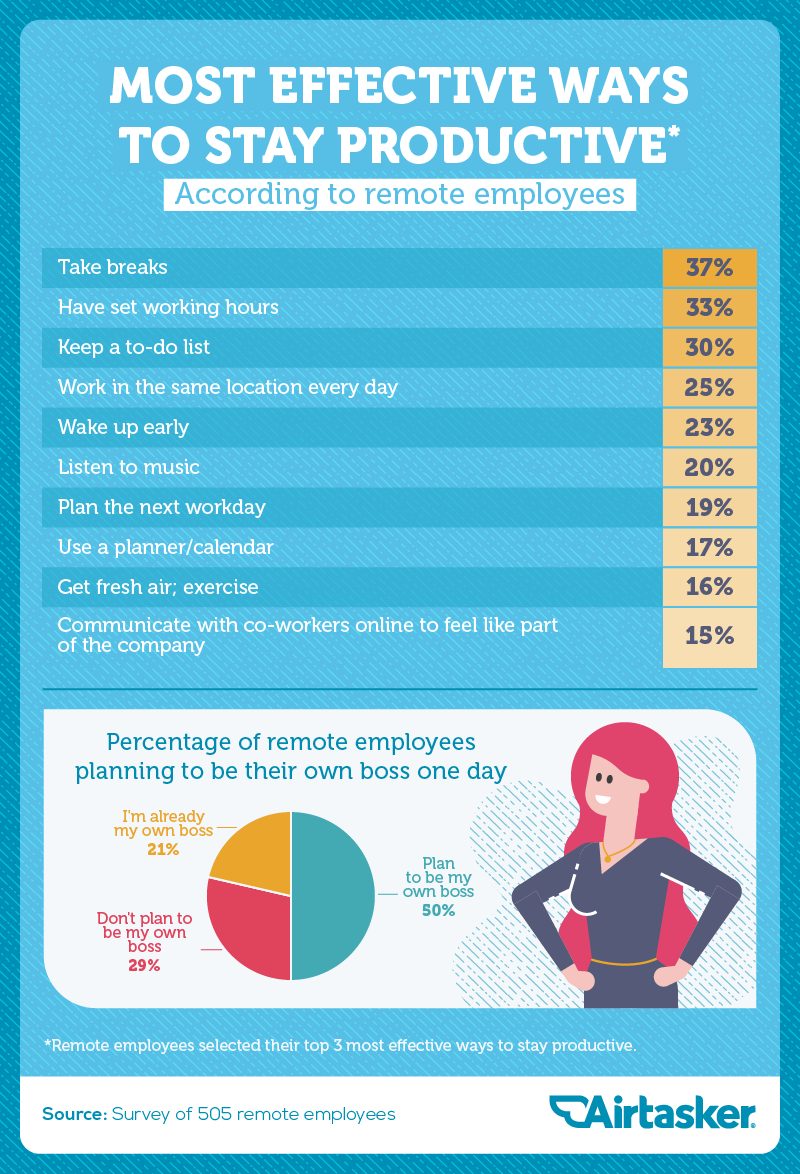
Given the evidence showing productivity improves with remote work, it would be easy to assume that increased efficiency simply comes with the remote lifestyle. But a closer look reveals something interesting: Many remote employees’ secrets to productivity are the same secrets that many office employers try to enforce. For example, 33% of remote employees insisted that having set working hours was the most effective way to stay productive. Another 25% stayed productive by choosing to work in the same location every day. This is starting to sound a bit like traditional office work, no? Nevertheless, the absolute No. 1 method remote workers suggested for staying productive was taking breaks, which are often required by law for at least every five consecutive hours of work.
Remote workers, however productive, may still be flight risks: 50% wanted to be their own boss one day, as opposed to working their way up the corporate ladder. Another 21% were already their own boss, perhaps choosing to use that power to stay remote, as opposed to finding a permanent office.
Pressing priorities
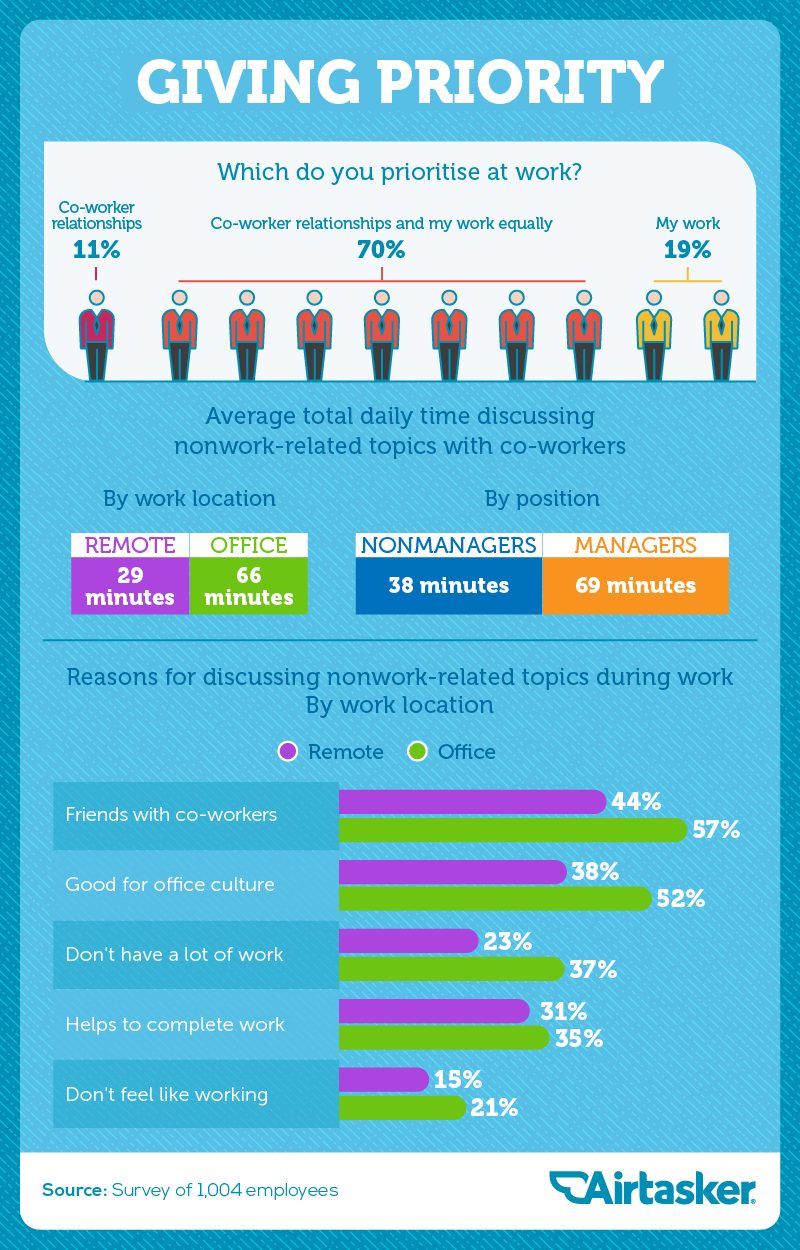
Priorities for all workers were well-balanced. The majority (70%) claimed that work and relationships with co-workers were equally important. Just 19% prioritised work over relationships. Those relationships, however, may be to the detriment of productivity, particularly if you’re an office worker. Office workers spent more than an hour each day talking to their co-workers about topics not related to work. Remote workers, on the other hand, only spoke to co-workers about non-work related topics for 29 minutes, 37 minutes less than their in-office counterparts.
If management is disappointed in the persistence of office chatter, they might be entering hypocritical territory. While non-management spent an average of 38 minutes discussing topics not related to work each day, management nearly doubled that number, talking with their co-workers for over an hour each workday. As a manager, be cognisant of the fact that your employees may be hesitant to cut you off, even if they need the time to get their work done.
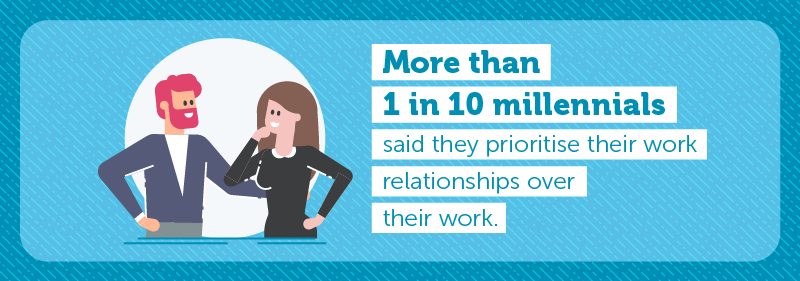
Discussing topics not related to work, however, may improve your work-related capabilities. Experts agree that your relationships at work can impact everything from your stress levels to productivity and even happiness, so it’s not necessarily great for a company to have employees discussing business exclusively. Instead, friendly conversations should be allowed to flourish.
Millennials understood the importance of office relationships the most. More than 1 in 10 millennials agreed that work relationships were more important than their workload, and they actively prioritised those bonds with their co-workers.
Supervision distractions
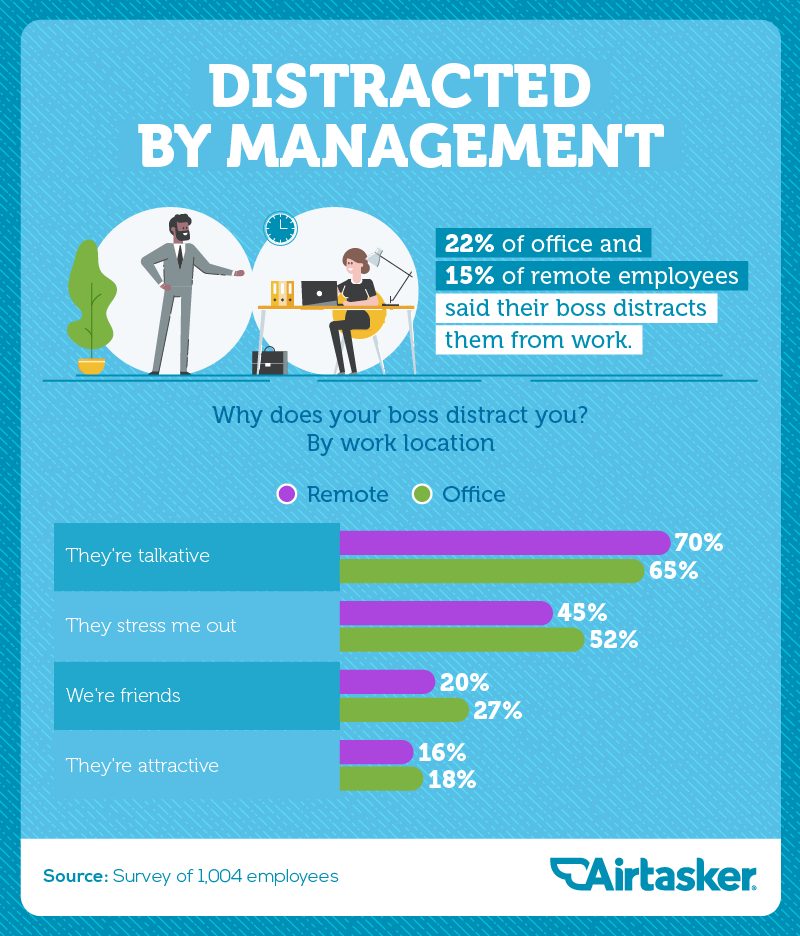
Employees tend to receive the blame for losing focus, and yet evidence reveals that it is actually the boss’s fault quite often, particularly if you work in an office. Nearly a quarter of office employees said their boss distracted them from doing their work. Sixty-five per cent of office workers said it was because their boss was too talkative, and another 52% said their boss stressed them out.
Only 15% of remote workers, on the other hand, said their boss had distracted them from work. As with office employees, the most likely reason for bosses being so distracting to their remote employees was being overly talkative. Most experts agree that, in a leadership role, it’s more important to be the boss than a friend. Your authority, and your employees’ productivity, can be compromised if you spend too much time chitchatting on company time.
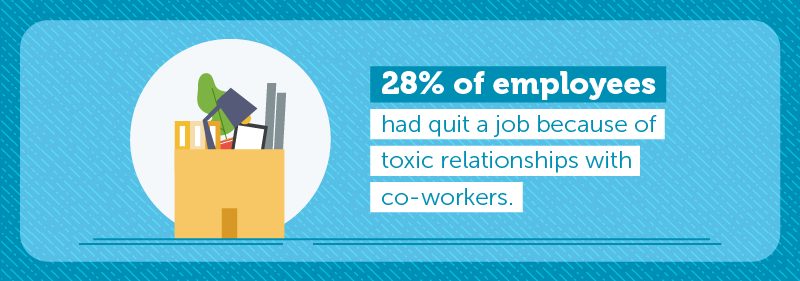
Still, it is important to maintain relationships, particularly for employee tenure. Twenty-eight per cent of employees had quit a job because of toxic relationships with their co-workers. It’s no secret that long-term employees are integral to a company’s well-being. So while healthy intercompany relationships can be good for your mental health, they can also be great for a company’s financial health.
Balancing act
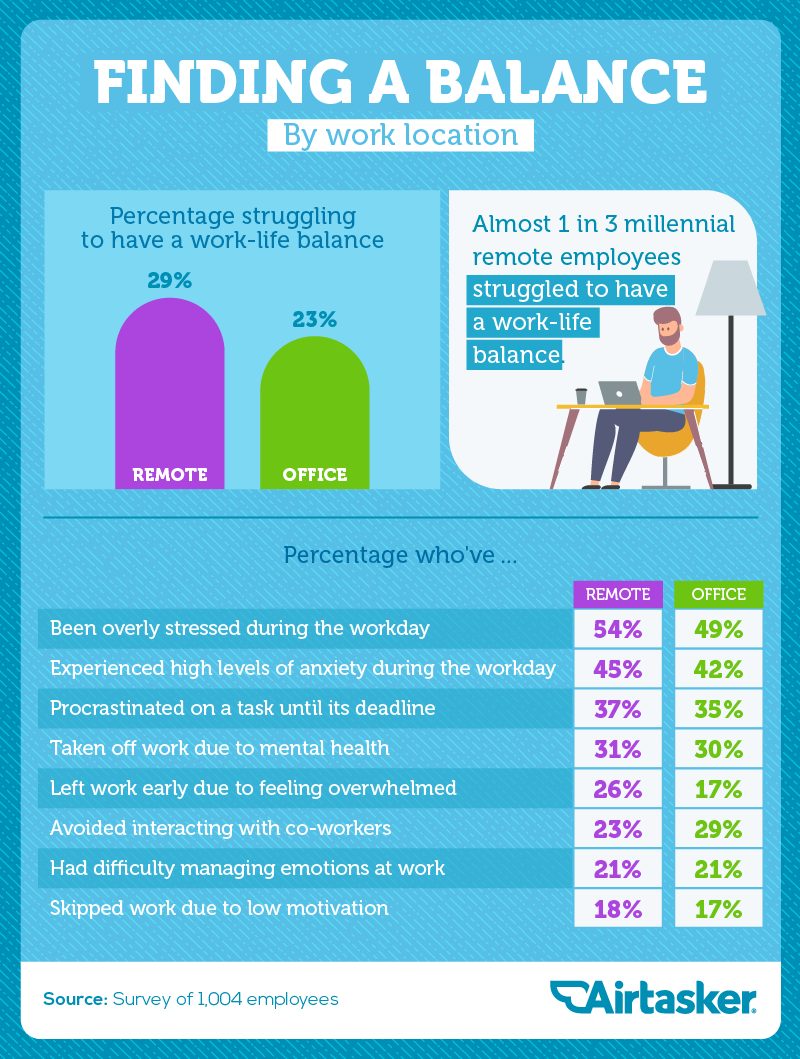
Without an office or traditional place to work, the line between work and personal life evidently begins to blur. In other words, remote employees have a worse work-life balance. While 29% of remote workers struggled to find a proper work-life balance, only 23% of office employees felt the same. And it got worse when it came to remote millennials: Almost 1 in 3 participants in this demographic found it difficult to maintain their own work-life balance.
Anxiety and stress also spiked working away from the office. Fifty-four per cent of remote employees said they had become overly stressed during the workday, and 45% experienced high levels of anxiety, compared to 49% and 42% of office employees, respectively. There was no difference, however, between remote and office workers when it came to the difficulty of managing emotions while at work: 21% of both groups cited strain in managing them. Nevertheless, it may be less embarrassing and more private if an inability to manage emotions occurs outside of the office.
Work your way
Working remotely might sound like a dream come true: It causes fewer distractions, removes the commute, and helps you save time and money. Win-win-win-win. But before you leave your job or request a remote schedule, remember that this lifestyle isn’t completely free of drawbacks. Evidence also shows that remote work correlates with higher levels of stress and longer workweeks. As with most career choices, it’s important to follow the paths that are best for you. Use services such as Marlee to find your strengths and blind spots.
Should you want to explore your options more in-depth, try browsing through Airtasker. We offer both jobs and helpers for all things, from business and administrative consulting to marketing and design. Whether you have the skills to offer or need the skills for hire, Airtasker has you covered (or hired!).
Methodology and limitations
We used Amazon’s Mechanical Turk to survey a total of 1,004 full-time employees. 505 were remote workers for the majority of the week, and 499 worked from an office for the majority of the week. Of all respondents, 47% were women, 53% were men, and less than 1% identified with a nonbinary gender. 61% of respondents were millennials (born 1981 to 1997); 29% were from Generation X (born 1965 to 1980); 8% were baby boomers (born 1946 to 1964); 2% were from Generation Z (born 1928 to 1943); less than 1% were from the silent generation (born 1928 to 1945); and less than 1% were from the greatest generation (born 1927 or earlier). The average age of respondents was about 36 with a standard deviation of about 10 years. To be considered in our data, respondents were required to a) complete all survey questions and b) pass an attention-check question in the middle of the survey. Participants who failed to do either of these were excluded from the study.
In visualisations where work location was not specified, responses from both remote and office workers were grouped. The data had a 3% margin of error for all employees, regardless of where they worked, and a 4% margin of error for remote workers specifically. For analysations of quantitative values, outliers were moved so that the findings could not be exaggerated.
Fair use statement
Whichever career path you choose, it’s important to have the essential information on hand. And this goes for your friends and co-workers as well. You’re free to share this article and its information with others for noncommercial purposes, so long as you link back to this page, giving proper credit to its contributors.
Sources
- https://www.forbes.com/sites/kevinkruse/2017/02/06/want-to-get-more-done-try-taking-more-breaks/#67ed0c476db4
- https://www.dol.gov/whd/state/meal.htm
- https://info.totalwellnesshealth.com/blog/how-your-work-relationships-impact-your-health
- https://trends.google.com/trends/explore?date=today%205-y&q=remote%20jobs
- https://smallbusiness.chron.com/longterm-employees-important-40711.html
- https://health.gov/news/blog/2017/05/five-reasons-employee-wellness-is-worth-the-investment/
- https://www.themuse.com/advice/ask-a-candid-boss-can-managers-be-friends-with-their-employees
- https://smallbusiness.chron.com/tax-incentives-companies-offer-gym-memberships-18505.html
- https://www.forbes.com/sites/abdullahimuhammed/2018/12/21/10-remote-work-trends-that-will-dominate-2019/#97a11a97c72a
- https://www.fastcompany.com/90318974/the-rise-of-remote-working-will-continue



